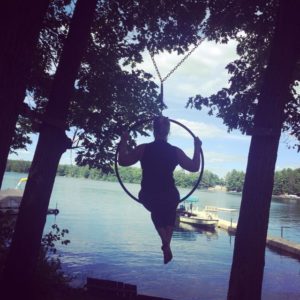As soon as I posted a picture of myself outside on a hoop I was inundated with emails on “I want to buy a hoop to hang from a tree”. BAD PAULA. You got people excited, thinking it was a simple thing to do and didn’t explain all the steps to actually hang from a tree or the inherent danger. I’m happy to help you purchase a hoop and recommend manufactures and hardware, but when it comes to rigging in nature there are LOTS of other things to consider.
Firstly, the general rule of thumb is that hanging from trees in dangerous. You do NOT know the condition of the tree. You should hire an arborist first to get a core sample from the tree to help assess health, but even that won’t give you the full picture of the tree. Trees may look totally safe on the outside and then have something inside them that will kill you if you try to hang from! Don’t believe me? Look at this:
So yes, hanging from trees is an idea that if contemplated at all must be done very carefully. Most aerialist and riggers will instead encourage you to purchase a free-standing rig to do your hoop and hammock in nature. I would totally have taken this route if it had been an option! Two that I like are Ludwig Quad Rig and the Trapeze Quad Rig. Note that both the rigs I am recommending are quad rigs (four legs) not a tripod with only 3 legs!
Back to trees. What should you DEFINITELY NOT DO? Hang any aerial apparatus from a single point on a Tree. The lovely branch that looks just perfect to throw a sling over and hang your hoop will kill you. The force generated doing aerial, especially hoop, is MUCH higher than your body weight. A general rule of thumb is to expect a force of 750 pounds. Then to be safe you want a safety factor of at least 5:1 (note 8:1 or 10:1 would be better!), so now that means you should be asking that branch to hold a minimum of 3,750 pounds. BAD IDEA. Also you don’t want a single point because if it does break you have no redundant safety.
So now you’re thinking that you’ll tie a line between two trees and hang from it. Better. BUT make sure that line isn’t a tightrope! If you know trigonometry you’ll know that the amount of force on your vector greatly increases as a V shape gets closer to a – shape. That means that those pounds I was talking about before will get even greater on your attachment point as the line become straighter between your two trees. Therefore, if rigging between two trees you need the attachment points to be high enough that you can have a lovely curved shape on your rope with a pleasing angle (do math!) So to connect your hoop 10 ft off the ground that means you need to connect to the tree 25 or so feet in the air and then have the connective line curve down. That is a hell of a long way up to connect your line. The idea of someone being on a ladder that high makes me very scared. So again, BAD IDEA. Might I recommend the quad rigs again?
A lot of people just want to tie a rope around two trees and call it done. The problem with this is that ropes will be in the elements and deteriorate. Also, tying a rope around a tree actually strangles the tree and makes it weaker. BAD IDEA. If you truly must tie yourself to a tree, please get the proper iBolts that have a forged loop that go all the way through the tree and are bolted. Again, note that you have no idea how strong the tree actually is (see video above).
So how did I get my outdoor tree rig? I talked to an arborist and worked with an engineer. I purchased all high rated equipment that could take the pounds of force anticipated. Math was done to calculate the optimal angle for my attachment point to trees. Each attachment point has a redundant safety so if the first bolt breaks there is a something else holding it long enough for me to get down, hopefully. And every time before using it I inspect the entire system and proof load test it to make sure nothing has changed since my last time. With all of that in place do I feel safe? No. Not really. I would prefer a free-standing rig that I knew wouldn’t fail. At the end of all this work, the tree could still fail and I won’t know until I’m crushed. So every time I’m on my outdoor attachment I’m hesitant and super careful. I don’t do big tricks on it, it is simply a place for me to keep my skills up when I’m not near the studio.
If I could have done this with a free-standing rig I would have. That is still my first recommendation! But I did not want all of you seeing pictures of aerial in nature and thinking of hanging yourself from a tree this weekend. If you must go the tree route, do your homework and make sure you have multiple attachment points and safety redundancies in place. And lastly, if you are doing any type of aerial sports, USE A CRASH MAT!!!!!! This is non-negotiable to me, I have one under me anytime I practice including outdoors! You should always have a crash mat under you when working on any new skill or combination. My favorite source for crash mats is Tumbl Trak! Our new studio mats are from them and they are FANTASTIC. Please please please, be safe! Just because you see it on Instagram doesn’t make it easy to do or the best practice.

(920) 750-1441
info@aerialdancepoleexercise.com
